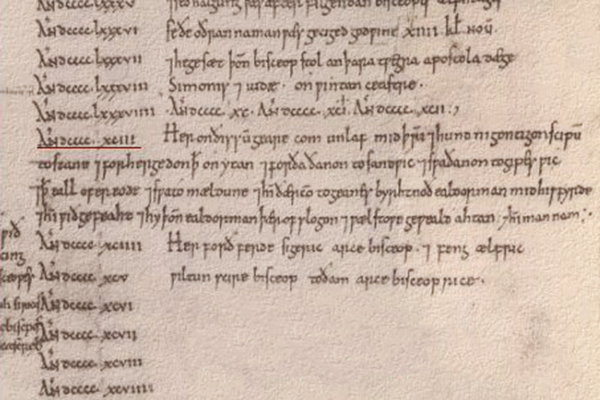

This page from the Anglo-Saxon Chronicle (Winchester MS) records the entry for AD 993, and begins "Here in this year Anlaf [Olaf] came..." In the column on the left, one can see that the years were written out first and a single line set aside for each. With the arrival of the Vikings, however, the chronicler was obliged to make room for that year's entry by erasing some of the numbers and writing over them. Still, there was not enough space and he continued his account in the margin.
There is some confusion as to when these events actually occurred. The annal is entered under the year 993 and concludes "And afterwards they made peace with them and the king received him [Olaf] at the bishop's hands [as sponsor at baptism]." But a mark over the year 991 seems to associate at least some of the events with that year. The other versions of the Chronicle speak of Olaf and ninety-four ships, as well as Sweyn Forkbeard, in the annal for 994, and it may be that the scribe of the Winchester MS has dislocated one year (993 for 994), which later was marked as belonging to 991, and conflated the entries which originally belonged to 991 and 994. The ninety-three ships that were to have arrived in 991 may be the same ninety-four ships (iiii having been misread as iii) that came to England in 994. If later events have been included in the earlier account, Olaf may not have been at Maldon or it is possible that Sweyn Forkbeard was there.
Nor is the date for the Battle of Maldon any more certain. A late twelfth-century church calendar for Ely, where Byrhtnoth is buried, records his death as August 10. But an early eleventh-century calendar from Winchester indicates it to be August 11. It is testimony to Byrhtnoth's fame that he still was being celebrated as a hero two hundred years after his death, a distinction shared only with Alfred and Æthelstan.